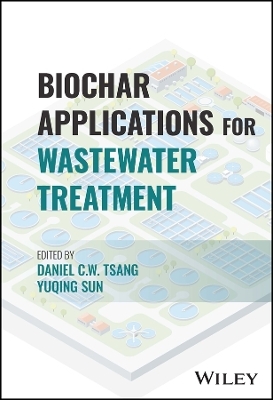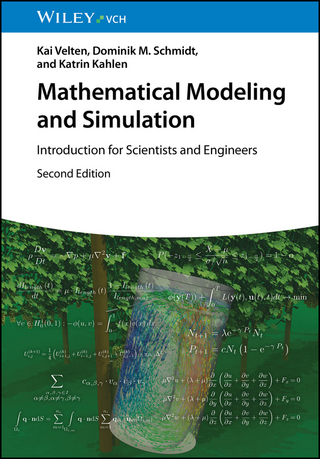
Biochar Applications for Wastewater Treatment
John Wiley & Sons Inc (Verlag)
978-1-119-76437-3 (ISBN)
Biochar Applications for Wastewater Treatment summarizes recent research development on biochar production and emerging applications with a focus on the value-added utilization of biochar technology in wastewater treatment, succinctly summarizing different technologies for biochar production and characterization with an emphasis on feedstock selection and pre-/post- treatment. The text discusses the mechanisms of biochar’s various roles in different functions of wastewater treatment and includes the latest research advances in manufacturing optimization and improvements to update the carbonaceous materials with desirable environmental functionalities.
Discussion and case studies are incorporated in treating municipal wastewater, industrial wastewater, agricultural wastewater, and stormwater to illustrate and emphasize the promising prospects of biochar technology in the treatment of various wastewater in actual utilization. Perspectives and future research directions of the emerging biochar technology in wastewater treatment are presented to provide insights for the readers and researchers in biochar application in wastewater treatment.
Sample topics covered in Biochar Applications for Wastewater Treatment include:
Different technologies for biochar production and characterization
Adsorption, biofiltration, anaerobic degradation, sludge dewatering and composting, nutrient recovery, advanced oxidation process, and odor control
Removal of pharmaceuticals, personal care products, and emerging contaminants
Fate and transport in the environment, and life cycle assessment
Biochar Applications for Wastewater Treatment is an essential resource for professionals in environmental engineering/sciences, water and waste management, and sustainable environmental development looking for a comprehensive overview of the subject. The text is also valuable for academics interested in wastewater treatment technologies using biochar as a carbon-negative alternative to conventional materials.
Daniel C.W. Tsang is Pao Yue-Kong Chair Professor in State Key Laboratory of Clean Energy Utilization at Zhejiang University. Dan strives to develop low-carbon engineering solutions to ensure sustainable urban development and attain carbon neutrality. Dan has published over 500+ articles in top 10% journal (h-index 109, Scopus). Dan was selected as Highly Cited Researchers 2022 in the academic fields of Engineering as well as Environment and Ecology. Yuqing Sun is an Assistant Professor in the School of Agriculture at Sun Yat-Sen University. Her research covers the customized design and application of engineered biochar in green and sustainable wastewater treatment. Dr. Sun has published 50+ publications in top 10% journals (h-index 38, Scopus). Dr. Sun was selected as Highly Cited Researchers 2022 in the academic field of Cross Field.
Editors Biography xi
List of Contributors xiii
Preface xv
1 Engineered Biochar 1
Yuqing Sun and Daniel C.W. Tsang
1.1 Overview of Biochar Production 2
1.2 Biochar Properties and Characterization 4
1.3 Pre- and Post-Modification of Biochar 9
1.3.1 Physical Modification 10
1.3.2 Chemical Modification 14
1.3.3 Biochar Composites 16
1.4 Sustainability Considerations 24
2 Adsorption of Nutrients 29
Yuqing Sun and Daniel C.W. Tsang
2.1 Nutrients in Wastewater 29
2.2 Biochar Performance in Nutrients Removal from Wastewater 31
2.2.1 Removal of Ammonium Using Modified and Pristine Biochars 31
2.2.2 Removal of Nitrate Using Pristine and Modified Biochars 32
2.2.3 Removal of Phosphate Using Pristine and Modified Biochars 33
2.3 Biochar Mechanisms of Nutrients Removal from Wastewater 34
2.3.1 Specific Surface Area 34
2.3.2 Ion Exchange 34
2.3.3 Surface Functional Groups 34
2.3.4 Precipitation 35
2.4 Factors Influencing Biochar Performance in Nutrients Removal 35
2.4.1 Pyrolysis Temperature 35
2.4.2 Metallic Oxides on Biochar 36
2.4.3 Solution pH 36
2.4.4 Contact Time 36
2.4.5 Ambient Temperature 37
2.4.6 Coexisting Ions 37
2.5 Nutrients Desorption from Biochar 38
2.5.1 Ammonium Desorption 38
2.5.2 Nitrate Desorption 38
2.5.3 Phosphorous Desorption 39
2.6 Nutrient-loaded Biochar as Potential Nutrient Suppliers 39
3 Adsorption of Metals/Metalloids 41
Yuqing Sun and Daniel C.W. Tsang
3.1 Metals/Metalloids in Wastewater 42
3.2 Mechanisms of Biochar for Adsorption of Metals/Metalloids 43
3.2.1 Physical Adsorption 43
3.2.2 Electrostatic Interaction 44
3.2.3 Ion Exchange 45
3.2.4 Surface Complexation 45
3.2.5 Precipitation 45
3.2.6 Reduction 46
3.3 Modified Biochar for Adsorption of Metals/Metalloids 46
3.3.1 Biochar/Layered Double Hydroxide Composites 46
3.3.2 Magnetic Biochar Composites 47
3.3.3 Biochar-Supported nZVI Composites 48
3.3.4 Comparison of Different Modification Methods for Metals/Metalloids 49
3.4 Biochar Recycling after Adsorption of Metals/Metalloids 51
4 Adsorption of PPCPs 53
Yuqing Sun and Daniel C.W. Tsang
4.1 PPCPs in Wastewater 54
4.2 Biochar Mechanisms for PPCPs Adsorption 55
4.2.1 π-π Interaction 55
4.2.2 Hydrogen Bonding 56
4.2.3 Electrostatic Interaction 56
4.2.4 Other Mechanisms 56
4.3 Factors Affecting PPCPs Adsorption by Biochar 57
4.3.1 Pyrolysis Temperature 57
4.3.2 Biochar Surface Modification 57
4.3.3 Properties of PPCPs 58
4.3.4 Environmental pH 59
4.3.5 Wastewater Composition 59
5 Stormwater Biofiltration Media 61
Jingyi Gao, Yuqing Sun, and Daniel C.W. Tsang
5.1 Introduction 62
5.2 Common Pollutants in Stormwater 64
5.3 Biochar for Biofiltration Media 66
5.3.1 Production of Biochar 66
5.3.2 Physicochemical Properties of Biochar 67
5.4 Removal of Pollutants in Biochar-Based Biofiltration Systems 67
5.4.1 Metals/Metalloids 67
5.4.2 Nutrient 70
5.4.3 Organic Chemicals 72
5.5 Microplastic in Urban Runoff 75
5.6 Challenge and Perspective 76
5.7 Conclusion 78
6 Biochar Solution for Anaerobic Digestion 89
Yanfei Tang, Wenjing Tian, and Daniel C.W. Tsang
6.1 Introduction 89
6.2 Application of BC as an Additive in Anaerobic Digestion 90
6.2.1 pH Buffering 90
6.2.2 Adsorption of Inhibitors 91
6.2.3 Effects on Microbial Growth and Activities 92
6.3 Effects of BC on Digestate Quality 99
6.4 Conclusions and Perspectives 100
7 Biochar-Assisted Anaerobic Ammonium Oxidation 105
Wenjing Tian, Yanfei Tang, Dongdong Ge, and Daniel C.W. Tsang
7.1 Overview of Anaerobic Ammonium Oxidation 105
7.1.1 Introduction 105
7.1.2 Constraints 107
7.2 Roles of Biochar in Promoting Anammox 108
7.2.1 pH and Inhibitor Buffer 111
7.2.2 Electron Transfer Promotion 112
7.2.3 Microbial Immobilization 113
7.3 Future Perspectives 114
8 Application of Biochar for Sludge Dewatering 121
Dongdong Ge, Nanwen Zhu, Mingjing He, and Daniel C.W. Tsang
8.1 Introduction 121
8.2 Preparation of Biochar-Based Sludge Conditioner 123
8.3 Efficacy of Biochar Conditioning on Enhanced Sludge Dewaterability 126
8.4 Variations of Sludge Physicochemical Characteristics via Biochar Conditioning 127
8.5 Technical Mechanism and Implementation Prospects 128
9 Effects of Biochar on Sludge Composting 137
Dong Li, Dongdong Ge, Yuqing Sun, and Daniel C.W. Tsang
9.1 Introduction 138
9.2 Effects of Biochar Addition on Sludge Composting 141
9.2.1 Effects on Compost Parameters Effect on C/N 141
9.2.2 Effects on Heavy Metals 142
9.2.3 Effects on Organic Matters 142
9.2.4 Effects on Gaseous Emissions 143
9.2.5 Effects on Microbial Community and Activities 145
9.2.6 Effects on Quality of Sludge Compost 145
9.3 Future Perspectives 146
9.4 Summary 147
10 Sludge Utilization as Biochar for Nutrient Recovery 155
Deng Pan, Dongdong Ge, and Daniel C.W. Tsang
10.1 Sewage Sludge (SS) Management 155
10.2 Importance of Sludge as a Feedstock for Biochar 156
10.3 Factors Affecting the Properties of SDBC 156
10.3.1 Raw Material 159
10.3.2 Temperature 159
10.3.3 Heating Rates 159
10.3.4 Retention Time 160
10.4 Nutrients in SDBC 160
10.4.1 Nitrogen (N) 160
10.4.2 Phosphorus (P) 161
10.4.3 Potassium (K) 161
10.5 SDBC for Soil Amendment and Nutrient Utilization 161
10.6 Current Challenges for SDBC 163
10.7 Conclusions 164
11 Biochar for Electrochemical Treatment of Wastewater 171
Dong Li, Yang Zheng, Yuqing Sun, and Daniel C.W. Tsang
11.1 Introduction 172
11.2 Different Electrochemical Behavior of Biochar 173
11.2.1 Electron Exchange 173
11.2.2 Electron Donor or Acceptor 174
11.2.3 Electrosorption Capacity 174
11.3 Preparation of Biochar Electrode Materials 177
11.3.1 Carbonization 177
11.3.2 Activation 178
11.3.3 Template 179
11.3.4 Composite Materials 180
11.4 Application in Electrochemical Wastewater Treatment 181
11.4.1 Electrochemical Oxidation 181
11.4.2 Electrochemical Deposition 182
11.4.3 Electro-adsorption 182
11.4.4 Electrochemical Disinfection 183
11.5 Future Perspectives 183
11.6 Summary 184
12 Peroxide-Based Biochar-Assisted Advanced Oxidation 193
Yang Cao, Qiaozhi Zhang, Yuqing Sun, and Daniel C.W. Tsang
12.1 Introduction 193
12.2 Biochar-Based Catalysts 195
12.2.1 Pristine Biochar 196
12.2.2 Redox Metal-Loaded Biochar 197
12.2.3 Heteroatom-Doped Biochar 198
12.3 Peroxide-Based Advanced Oxidation 199
12.3.1 Fenton-Like System 199
12.3.2 Persulfate Activation System 201
12.3.3 Photocatalytic System 203
12.4 Conclusion and Future Perspectives 204
13 Persulfate-Based Biochar-Assisted Advanced Oxidation 213
Mengdi Zhao, Zibo Xu, and Daniel C.W. Tsang
13.1 Introduction 213
13.2 Activation Pathway and Reaction Mechanism of Persulfate by Biochar 214
13.2.1 Distinction between Different Pathways 214
13.2.2 Properties Necessitating the Generation of Radicals with PS 215
13.2.3 Nonradical Degradation with Biochar 215
13.2.4 Modifying Biochar for Enhanced Properties Related to the Degradation Process 216
13.3 Metal-Biochar Composites in Persulfate Activation System 217
13.3.1 Iron-Biochar 218
13.3.2 Copper-biochar 219
13.3.3 Cobalt Biochar 219
13.3.4 Biochar of Other Metal and Mixed Metal 220
13.4 Heteroatom-Doped Biochar for PS Activation 220
13.4.1 Nitrogen-doped Biochar 221
13.4.2 Sulfur-Doped Biochar 222
13.5 Conclusion and Perspectives 222
14 Biochar-Enhanced Ozonation for Sewage Treatment 229
Dongdong Ge, Nanwen Zhu, Mingjing He, and Daniel C.W. Tsang
14.1 Introduction 229
14.2 Preparation of Biochar-Based Catalyst for Ozonation 230
14.3 Efficacy of Biochar-Catalytic Ozonation on Sewage Treatment 232
14.4 Effects of Process Conditions on Biochar-Enhanced Ozonation Sewage Treatment 233
14.5 Technical Mechanism and Implementation Prospects 235
15 Biochar-Supported Odor Control 243
Jingyi Gao, Zibo Xu, and Daniel C.W. Tsang
15.1 Causes and Treatment of Odor 244
15.2 Odor Pollutants 245
15.3 Properties of Biochar for the Removal of Odor Pollutants 247
15.3.1 Surface Area and Total Pore Volume 249
15.3.2 Pore Size Distribution 250
15.3.3 Chemical Functional Group 252
15.3.4 Noncarbonized Organic Matter 253
15.3.5 Mineral constituents 253
15.4 Application of Biochar in Odor Control 254
15.4.1 Biochar as Adsorbent 254
15.4.2 Biochar as Additives 256
15.5 Conclusion and Perspective 260
16 Fate, Transport, and Impact of Biochar in the Environment 273
Deng Pan, Yuqing Sun, and Daniel C.W. Tsang
16.1 Transport Mechanism of Biochar in the Environment 274
16.2 Stability of Biochar 275
16.2.1 Physical Degradation of Biochar 275
16.2.2 Chemical Decomposition of Biochar 275
16.2.3 Microbial Decomposition of Biochar 276
16.3 Contaminants in Biochar and the Environmental Impact 277
16.3.1 Polycyclic Aromatic Hydrocarbons (PAHs) 278
16.3.2 Heavy Metals (HMs) 279
16.3.3 Persistent Free Radicals (PFRs) 280
16.3.4 Dioxins 281
16.3.5 Metal Cyanide (MCN) 281
16.3.6 Volatile Organic Compounds (VOCs) 282
17 Environmental and Economic Evaluation of Biochar Application in Wastewater and Sludge Treatment 289
Claudia Labianca, Sabino De Gisi, Michele Notarnicola, Xiaohong Zhu, and Daniel C.W. Tsang
17.1 Introduction 289
17.2 Environmental Evaluation 291
17.2.1 LCA Insights into Biochar Production and Applications 291
17.2.2 Main LCA Literature Studies of Biochar Applications in Wastewater and Sludge Treatments 295
17.3 Technical, Economic, and Sustainability Considerations 299
17.4 Future Trends 301
17.5 Conclusions 302
Index 309
| Erscheinungsdatum | 05.08.2023 |
|---|---|
| Verlagsort | New York |
| Sprache | englisch |
| Gewicht | 263 g |
| Themenwelt | Naturwissenschaften ► Chemie |
| Technik ► Bauwesen | |
| ISBN-10 | 1-119-76437-8 / 1119764378 |
| ISBN-13 | 978-1-119-76437-3 / 9781119764373 |
| Zustand | Neuware |
| Informationen gemäß Produktsicherheitsverordnung (GPSR) | |
| Haben Sie eine Frage zum Produkt? |
aus dem Bereich


